Circular Economy as a Glocal Business Activity: Mobile Phone Repair in the Netherlands, Poland and China
Abstract
1. Introduction
2. Literature Review and Conceptual Background
3. Data and Method
4. Results
4.1. The Netherlands
4.1.1. Informality and Transitioning to Official Repair Business
4.1.2. Motivation Behind Establishing a Repair Shop and Profitability
4.1.3. Threats in the Business Ecosystem
4.1.4. Supplier Relations
4.1.5. Customer Relations
4.1.6. Circularity Oriented Economic Relations
4.1.7. Planned Obsolescence and the Future of the Repair Business in the Netherlands
4.2. China
4.2.1. Informality and Transitioning to Official Repair Business
4.2.2. Motivation Behind Establishing a Repair Shop and Profitability
4.2.3. Threats in the Business Ecosystem
4.2.4. Supplier Relations
4.2.5. Customer Relations
4.2.6. Circularity Oriented Economic Relations
4.2.7. Planned Obsolescence and the Future of the Repair Business in China
4.3. Poland
4.3.1. Informality and Transitioning to Official Repair Business
4.3.2. Motivation Behind Establishing a Repair Shop and Profitability
4.3.3. Threats in the Business Ecosystem
4.3.4. Supplier Relations
4.3.5. Customer Relations
4.3.6. Circularity Oriented Economic Relations
4.3.7. Planned Obsolescence and the Future of the Repair Business in Poland
5. Discussions and Conclusions
5.1. Price Squeeze
5.2. Increasing Technical Complexity
5.3. Increasing Competition
5.4. Circularity Relations
5.5. Policy Recommendations and Future Research Directions
Author Contributions
Funding
Acknowledgments
Conflicts of Interest
Appendix A
| Mobile Phone Repair Survey Questions | |
| Establishing the Business (11) | |
| Q1 | 1. What are the activities your business is involved in? |
| Q2 | 2. What is the share of revenue from repair activities in all activities? (%) |
| Q3 | 3. Are you involved in the business of selling refurbished mobile phones? |
| Q4 | 4. When did you enter the mobile phone repair business? (The year in which you became operational) |
| Q5 | 5. How long did it take you to establish your mobile repair shop (from idea to becoming operational)? in months: |
| Q6 | 6. Before starting an official business, did you repair mobile phones on an informal basis? (yes/no) |
| Q7 | 7. What business or other activity (education, unemployed etc.) were you involved in before you established a repair company? |
| Q8 | 8. What role did the following play in establishing a mobile repair shop? |
| The prospects of high profits | |
| Low Risks | |
| Previous Business Experience as shop owner | |
| I like repair work | |
| I like being a shop owner | |
| Social interactions with customers | |
| Other: | |
| Q9 | 9. How quickly was the repair of mobile phones profitable? Please only answer for activities related to the repair of mobile phones. In …. Months / in …..years |
| Q10 | 10. How many repair shops are there in your area (within 1 km2)? |
| Q11 | 11. Did competition increase or decrease in the last year? |
| Human Capital Needs (2) | |
| Q12 | 1. How many employees do you have? |
| Q13 | 2. On average, how many telephones could an employee repair per day? (a range can be given when people desire to do this, for example: 5 to 10 phones) |
| Part Inventory (9) | |
| Q14 | 1. From which countries do you purchase the parts (components)? |
| Q15 | 2. If you purchase parts from China, why? |
| Q16 | 3. Do you source parts via trade intermediaries? If so, in which country they are based? |
| Q17 | 4. What percentage of the parts is new? …% of the parts are new |
| Q18 | 5. Do you ask for a warranty for the parts? |
| Q19 | 6. Are you interested in using components from used phones more often? |
| Q20 | 6.1 What are the reasons why you are more interested in using components from used phones? |
| Q21 | 7. What is the most important reason for NOT using parts from used phones more often? |
| It is easy to get original parts | |
| Legal requirements for warranty | |
| Fears that consumers do not want this | |
| Absence of warranty | |
| Other reason (e.g., negative image) | |
| Q22 | 8. Do you quickly change part suppliers for cost reasons? |
| Q23 | 9. Is your relationship with suppliers based on formal contracts or informal relations? |
| Tool and Equipment Inventory (1) | |
| Q24 | 1. What is the origin of the tools to repair mobile phones? Please state the most important country e.g., China, other country (to be named) |
| Doing the Business (5) | |
| Q25 | 1. Do you repair all types of phones? Yes/no. If no, what phones do you not repair? |
| Q26 | 2. Do you give a warranty? Yes/no. If no, what warranty do you give? |
| Q27 | 3. Do you repair illegally produced phones? |
| Q28 | 4. Do you offer payable services beyond the repair of components? |
| Q29 | 5. Do such services constitute an important source of income for you? |
| Q30 | * Do you intend to offer payable services in the future? |
| Other Supply Chain Issues (7) | |
| Q31 | 1. Do you accept phones by postal mail? yes/no |
| Q32 | 2. Do you have contact with remanufacturers? yes/no |
| Q33 | 3. Do remanufacturers collect phones from your store? yes/no |
| Q34 | 4. Do you have contact with recyclers? yes/no |
| Q35 | 5. Do recyclers collect phones from your store? yes/no |
| Q36 | 6. Do you receive payments for giving phones from recyclers? yes/no |
| Q37 | 7. Do you receive or collect phones beyond repair? yes/no |
| Technical Capabilities, Infrastructure and Innovation (1) | |
| Q38 | 1. Have you bought new innovative tools and equipment in the last year? If so, what was new? |
| Customers (3) | |
| Q39 | 1. Do you buy phones from your customers for repair and resale? |
| Q40 | 2. What percentage of your sales is from phones which are repaired and resold? …% |
| Q41 | 3. Do you foresee an increase or decrease in telephone repairs in general? Why? |
| Threats (2) | |
| Q42 | 1. What are the main threats for your repair business? |
| Q43 | 2. Have phones become easy to repair? |
| Your Views (2) | |
| Q44 | 1. Could manufacturers do more to avoid the need for repair? |
| Q45 | 2. If more people would buy the phone, would this lead to more repairs or less repairs, and why? |
References
- European Commission. Directive 2002/96/EC of the European Parliament and of the Council of 27 January 2003 on Waste Electrical and Electronic Equipment (WEEE). Off. J. Eur. Union 2003, 37, 24. [Google Scholar]
- European Commission. Directive 2008/98/EC of the European Parliament and of the Council of 19 November 2008 on Waste and Repealing Certain Directives (Waste Framework Directive). 2008. Available online: https://eur-lex.europa.eu/legal-content/EN/TXT/?uri=celex%3A32008L0098 (accessed on 15 December 2018).
- European Commission. Circular Economy Strategy-Closing the Loop—An EU Action Plan for the Circular Economy. 2015. Available online: http://ec.europa.eu/environment/circulareconomy/index_en.htm (accessed on 15 December 2018).
- Ellen MacArthur Foundation. Ellen MacArthur Foundation—Rethink the Future. 2011. Available online: http://www.ellenmacarthurfoundation.org/circular-economy (accessed on 15 December 2018).
- Quariguasi, F.J.; Bloemhof, J. An analysis of the Eco-Efficiency of remanufactured personal computers and mobile phones. Prod. Oper. Manag. 2012, 21, 101–114. [Google Scholar] [CrossRef]
- Velmurugan Manivannan, S. Environmental and health aspects of mobile phone production and use: Suggestions for innovation and policy. Environ. Innov. Soc. Transit. 2016, 21, 69–79. [Google Scholar] [CrossRef]
- Ramani, S. Groundhog Day or Tipping Point for the Circular Economy? 2018. Available online: https://www.merit.unu.edu/groundhog-day-or-tipping-point-for-the-circular-economy/ (accessed on 15 December 2018).
- Statista. Number of Mobile Phone Users Worldwide from 2013 to 2019 (In Billions). 2018. Available online: https://www.statista.com/statistics/274774/forecast-of-mobile-phone-users-worldwide/ (accessed on 15 December 2018).
- Statista. Number of Smartphones Sold to end Users Worldwide from 2007 to 2017 (In Million Units). 2018. Available online: https://www.statista.com/statistics/263437/global-smartphone-sales-to-end-users-since-2007/ (accessed on 15 December 2018).
- Newzoo. Top 50 Countries by Smartphone Users and Penetration. 2017. Available online: https://newzoo.com/insights/rankings/top-50-countries-by-smartphone-penetration-and-users/ (accessed on 15 December 2018).
- Business Insider. The 10 Best Smartphones You Can Buy Right Now—Ranked by Price. Available online: https://www.businessinsider.nl/10-best-smartphones-you-can-get-2017-2017-12/?international=true&r=US Author: Edoardo Maggio (accessed on 27 December 2017).
- Defra. An Analysis of the Spectrum of Re-Use. A Component of the Remanufacturing Pilot, for Defra, BREW Programme; Oakdene Hollins Ltd.: Aylesbury, UK, 2007; Available online: http://www.remanufacturing.org.uk/pdf/story/1p374.pdf (accessed on 15 December 2018).
- Liao, C.H.; Zhang, Y.B. The estimation study on the amount of waste mobile phones in China. Ecol Econ. 2012, 3, 124–126. (in Chinese). [Google Scholar]
- Sarath, P.; Bonda, S.; Mohanty, S.; Nayak, S.K. Mobile phone waste management and recycling: Views and trends. Waste Manag. 2015, 46, 536–545. [Google Scholar] [CrossRef] [PubMed]
- Sabbaghi, M.; Behdad, S. Consumer decisions to repair mobile phones and manufacturer pricing policies: The concept of value leakage. Resour. Conserv. Recycl. 2018, 133, 101–111. [Google Scholar] [CrossRef]
- Vogtlander, J.G.; Scheepens, A.E.; Bocken, N.M.; Peck, D. Combined analyses of costs, market value and eco-costs in circular business models: Eco-efficient value creation in remanufacturing. J. Remanuf. 2017, 7, 1–7. [Google Scholar] [CrossRef]
- Hobson, K.; Lynch, N.; Lilley, D.; Smalley, G. Systems of practice and the Circular Economy: Transforming mobile phone product service systems. Environ. Innov. Soc. Transit. 2018, 26, 147–157. [Google Scholar] [CrossRef]
- Riisgaard, H.; Mosgaard, M.; Zacho, K.O. Local Circles in a Circular Economy-the Case of Smartphone Repair in Denmark. Eur. J. Sustain. Dev. 2016, 5, 109. [Google Scholar]
- Watson, D.; Gylling, A.C.; Tojo, N.; Throne-Holst, H.; Bauer, B.; Milios, L. Circular Business Models in the Mobile Phone Industry; Nordic Council of Ministers’ TemaNord Report 2017; Nordic Council of Ministers: Copenhagen, Denmark, 2017; p. 560. [Google Scholar]
- Wieser, H.; Tröger, N. Exploring the inner loops of the circular economy: Replacement, repair, and reuse of mobile phones in Austria. J. Clean. Prod. 2018, 172, 3042–3055. [Google Scholar] [CrossRef]
- Cao, J.; Chen, Y.; Shi, B.; Lu, B.; Zhang, X.; Ye, X.; Zhai, G.; Zhu, C.; Zhou, G. WEEE recycling in Zhejiang Province, China: Generation, treatment, and public awareness. J. Clean. Prod. 2016, 127, 311–324. [Google Scholar] [CrossRef]
- Greenpeace. Greenpeace Global Mobile Survey 2016. Available online: http://opendata.greenpeace.org/dataset/global-mobile-survey (accessed on 15 December 2018).
- Deloitte. Global Mobile Consumer Survey—Dutch Edition. 2017. Available online: https://www2.deloitte.com/content/dam/Deloitte/nl/Documents/technology-media-telecommunications/2017%20GMCS%20Dutch%20Edition.pdf (accessed on 15 December 2018).
- Statcounter. Mobile Vendor Market Share Poland 2017–2018. 2018. Available online: http://gs.statcounter.com/vendor-market-share/mobile/poland (accessed on 15 December 2018).
- Xu, C.; Zhang, W.; He, W.; Li, G.; Huang, J. The situation of waste mobile phone management in developed countries and development status in China. Waste Manag. 2016, 58, 341–347. [Google Scholar] [CrossRef] [PubMed]
- Porter, M.E. The competitive advantage of nations. Compet. Intell. Rev. 1990, 1, 14. [Google Scholar] [CrossRef]
- Snowdon, B.; Stonehouse, G. Competitiveness in a globalised world: Michael Porter on the microeconomic foundations of the competitiveness of nations, regions, and firms. J. Int. Bus. Stud. 2006, 37, 163–175. [Google Scholar] [CrossRef]
- Rugman, A.M. Porter takes the wrong turn. Bus. Q. 1992, 56, 59–64. [Google Scholar]
- Dunning, J.H. Internationalizing Porter’s diamond. Manag. Int. Rev. 1993, 33, 7–15. [Google Scholar]
- Waverman, L. A Critical Analysis of Porter’s Framework on the Competitive Advantage of Nations; Alan, M.R., Julien, V.D.B., Alain, V., Eds.; Beyond the Diamond (Research in Global Strategic Management, Volume 5); Emerald Group Publishing Limited: Bingley, UK, 1995; pp. 67–95. [Google Scholar]
- Gunter, J. Circular Economy isn’t just Recycling Products; Repair and Reuse Are also Vital. The Guardian. Available online: www.the guardian.com/sustainable-business/circular-economy-recyling-repair-reuse (accessed on 4 December 2013).
- Benton, D.; Coats, E.; Hazell, J. A Circular Economy for Smart Devices: Opportunities in the US, UK and India; Green Alliance: London, UK, 2015. [Google Scholar]
- Kang, H.; Schoenung, J.M. Electronic waste recycling: A review of US infrastructure and technology options. Resour. Conserv. Recycl. 2005, 45, 368–400. [Google Scholar] [CrossRef]
- Kahhat, R.; Kim, J.; Xu, M.; Allenby, B.; Williams, E.; Zhang, P. Exploring e-waste management systems in the United States. Resources. Conserv. Recycl. 2008, 52, 955–964. [Google Scholar] [CrossRef]
- Huang, K.; Guo, J.; Xu, Z. Recycling of waste printed circuit boards: A review of current technologies and treatment status in China. J. Hazard. Mater. 2009, 164, 399–408. [Google Scholar] [CrossRef]
- Ghisellini, P.; Cialani, C.; Ulgiati, S. A review on circular economy: The expected transition to a balanced interplay of environmental and economic systems. J. Clean. Prod. 2015, 114, 11–32. [Google Scholar] [CrossRef]
- King, A.M.; Burgess, S.C.; Ijomah, W.; McMahon, C.A. Reducing waste: Repair, recondition, remanufacture or recycle? Sust. Dev. 2006, 14, 257–267. [Google Scholar] [CrossRef]
- Stahel, W.R. The Utilization Focused Service Economy: Resource Efficiency and Product Life Extension, in The Greening of Industrial Ecosystems; National Academy Press: Washington, DC, USA, 1994; pp. 178–190. [Google Scholar]
- Ijomah, W. A Model—Based Definition of the Generic Remanufacturing Business Process. Ph.D. Thesis, University of Plymouth, Plymouth, UK, 2002. [Google Scholar]
- Ijomah, W.L.; Chiodo, J.D. Application of active disassembly to extend profitable remanufacturing in small electrical and electronic products. Int. J. Sustain. Eng. 2010, 3, 246–257. [Google Scholar] [CrossRef]
- Guest, G.; Bunce, A.; Johnson, L. How Many Interviews Are Enough? An Experiment with Data Saturation Variability. Field Methods 2006, 18, 59–82. [Google Scholar] [CrossRef]
- Galvin, R. How many interviews are enough? Do qualitative interviews in building energy consumption research produce reliable knowledge? J. Build. Eng. 2015, 1, 2–12. [Google Scholar] [CrossRef]
- Brix-Asala, C.; Geisbüsch, A.K.; Sauer, P.C.; Schöpflin, P.; Zehendner, A. Sustainability Tensions in Supply Chains: A Case Study of Paradoxes and Their Management. Sustainability 2018, 10, 424. [Google Scholar] [CrossRef]
- Charter, M. Designing for the Circular Economy; Charter, M., Ed.; Routledge: Abingdon, NY, USA, 2018. [Google Scholar]
- Charter, M. Repair Cafes. J. Peer Prod. 2018, 3. Available online: http://peerproduction.net/wp-content/uploads/2018/07/jopp_issue12_charter.pdf (accessed on 15 December 2018).
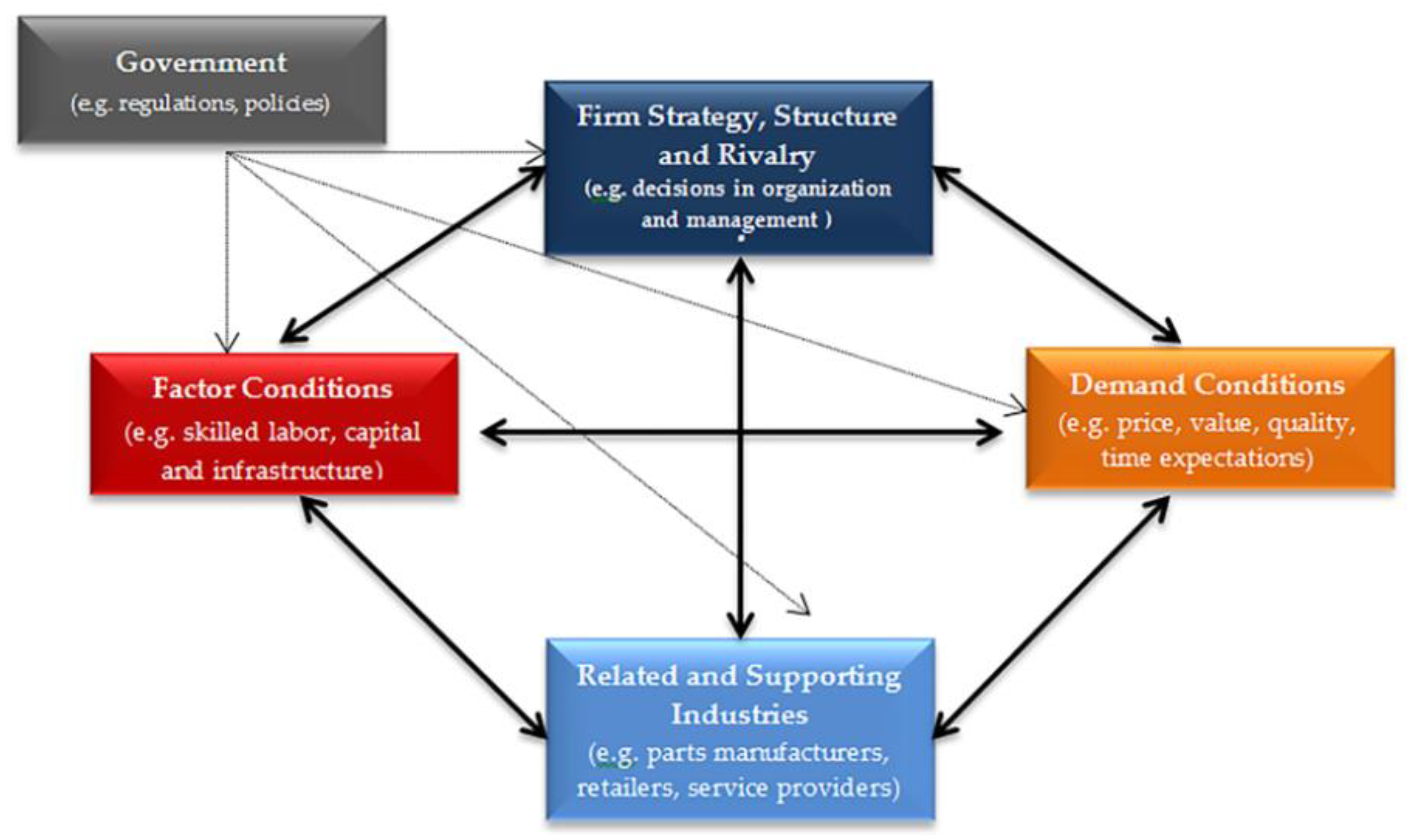
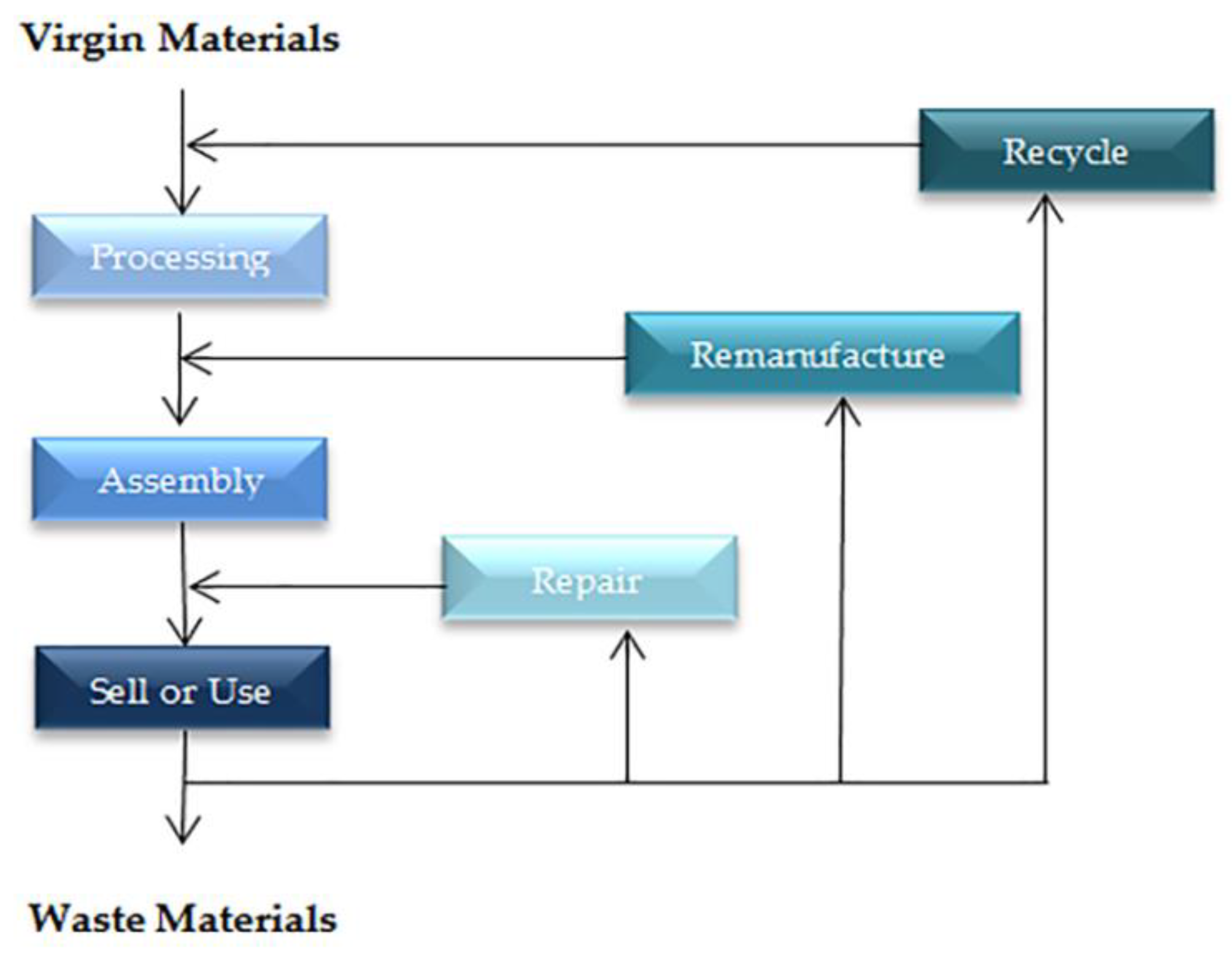
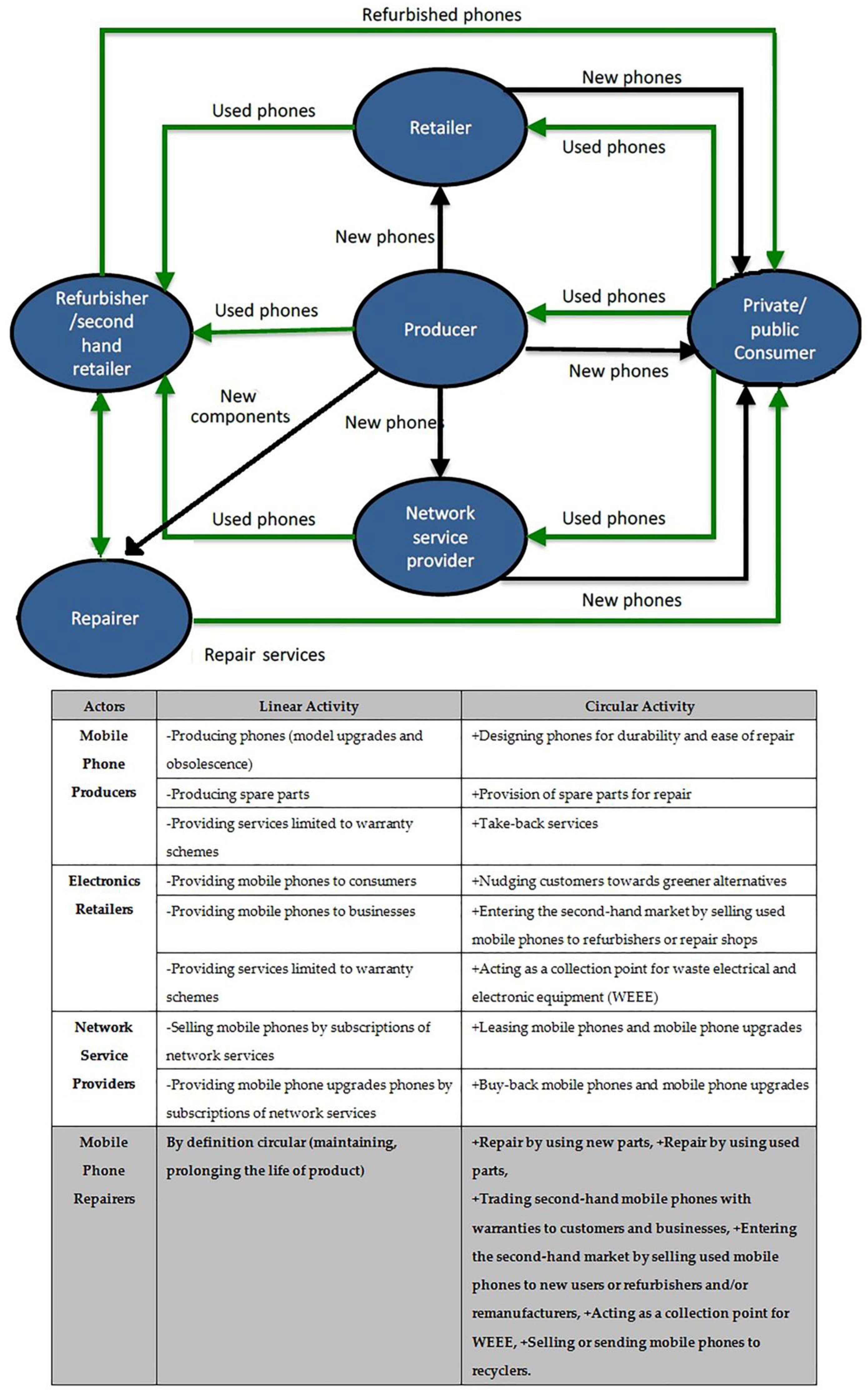
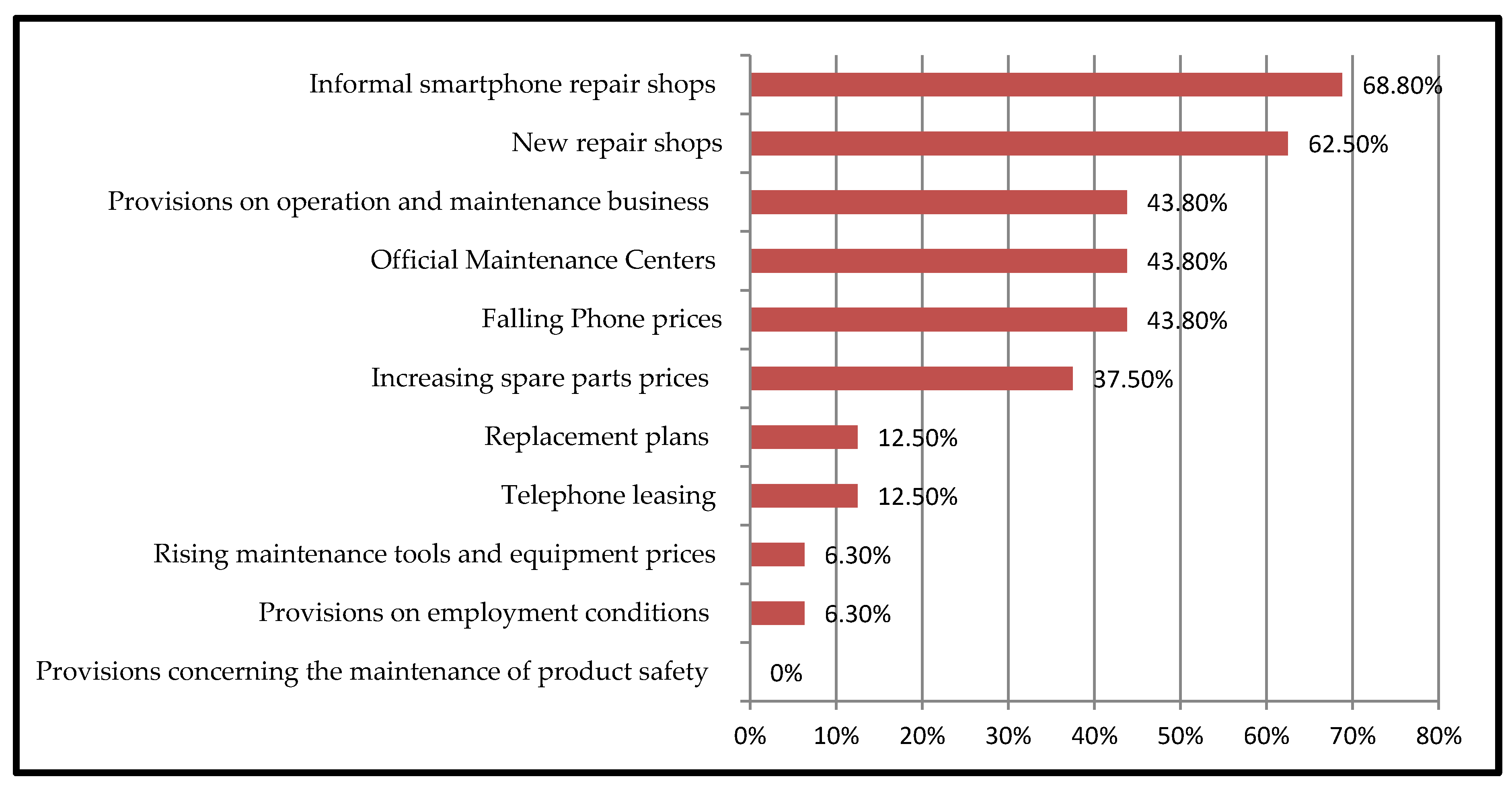
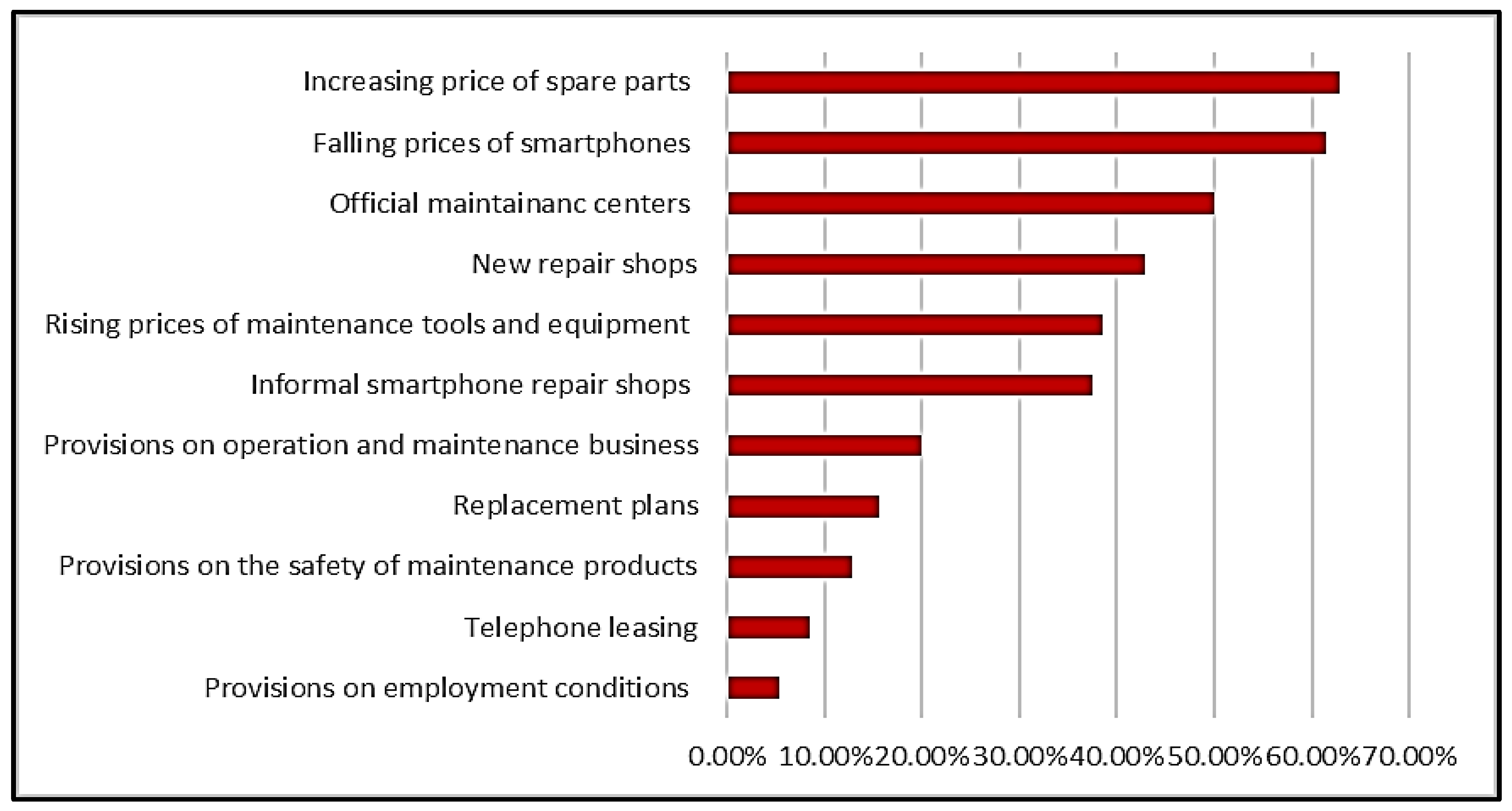
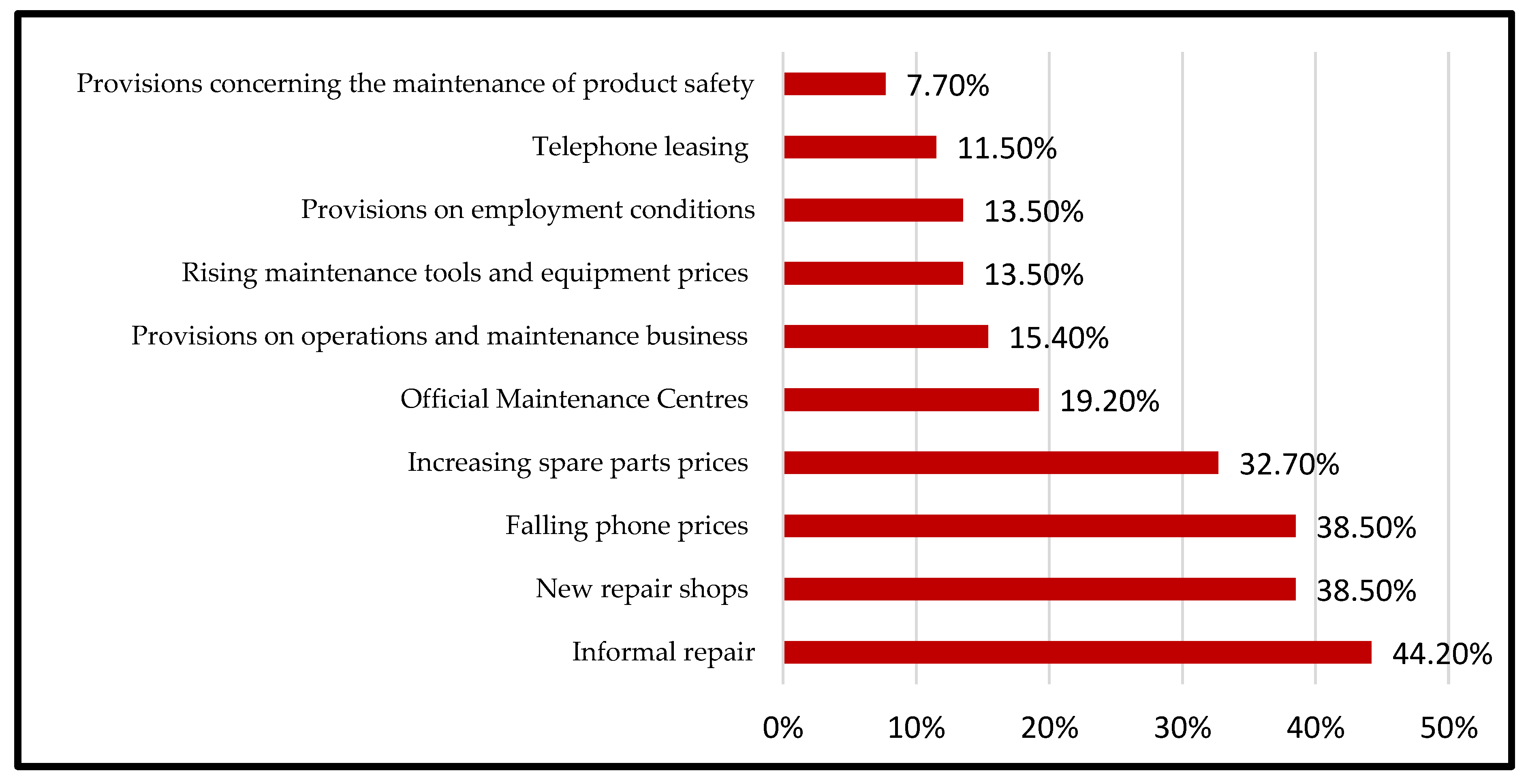
| Survey Sub-Sections | Corresponding theoretical components and interactions |
| Establishing the Business | Firm strategy, structure and rivalry |
| Human Capital Needs | Factor conditions |
| Part Inventory | Firm strategy, structure and rivalry |
| Tool and Equipment Inventory | Firm strategy, structure and rivalry |
| Doing the Business | Firm strategy, structure and rivalry; Related and Supporting Industries |
| Other Supply Chain Issues | Related and Supporting Industries |
| Technical Capabilities, Infrastructure and Innovation | Firm strategy, structure and rivalry |
| Customer Relations | Demand conditions |
| Threats | Government; Firm strategy, structure and rivalry; Factor conditions; Demand conditions; Related and Supporting Industries |
| Views on Mobile Phone Manufacturers | Firm strategy, structure and rivalry |
| Survey Questions | NL (n = 17) | PL (n = 52) | CH (n = 70) | |
|---|---|---|---|---|
| Establishing the Business | ||||
| Q3 | 3. Are you involved in the business of selling refurbished mobile phones? (yes/no) | 47.10% (yes) | 23.10% (yes) | 15.71% (yes) |
| Q5 | 5. How long did it take you to establish your mobile repair shop (from idea to becoming operational)? in months: | 2 to 4 years | In a few months | At least 6 months |
| Q6 | 6. Before starting an official business, did you repair mobile phones on an informal basis? (yes/no) | 29.40% (yes) | 15.40% (yes) | 65.70% (yes) |
| Q7 | 7. What business or other activity (education, unemployed etc.) were you involved in before you established a repair company? | Educational background in IT or IT-related fields. Previous areas of business vary, yet all related to services sector, such as construction services, cooling and air-conditioning services, logistics, car repair, insurance sales, outlet sales, sports and gym management | Very diverse professional experience, such as production work, customer care, advertisement, or watchmaker. Also, education varies from general secondary school to higher education in IT or chemistry | Most of the respondents worked in IT related occupations. A few of the respondents were engaged in other business, such as salesmen and attendants. |
| Q11 | 11. Did competition increased in the last year? | 76.50% (yes) | 50% (yes) | 68.57% (yes) |
| Part Inventory | ||||
| Q17 | 4. What percentage of the parts is new? …% of the parts are new | 95% | 34.60% | 68.60% |
| Doing the Business | ||||
| Q26 | 2. Do you give a warranty? (yes/no) | 100% | 100% | 74.29% |
| Other Supply Chain Issues | ||||
| Q31 | 1. Do you accept phones by postal mail? yes/no | 94.10% (yes) | 82.70% (yes) | 51.43% (yes) |
| Q32 | 2. Do you have contact with remanufacturers? yes/no | 23.50% (yes) | 26.90% (yes) | 24.29% (yes) |
| Q33 | 3. Do remanufacturers collect phones from your store? yes/no | 0% (yes) | 15.36% (yes) | 42.86%(yes) |
| Q34 | 4. Do you have contact with recyclers? yes/no | 64.70% (yes) | 34.60%(yes) | 58.57%(yes) |
| Q36 | 6. Do you receive payments for giving phones from recyclers? yes/no | 11.70%(yes) | 7.68%(yes) | 61.43%(yes) |
| Q37 | 7. Do you receive or collect phones beyond repair? yes/no | 41.20%(yes) | 67.30%(yes) | 50%(yes) |
| Customers | ||||
| Q39 | 1. Do you buy phones from your customers for repair and resale? (yes/no) | 64.70%(yes) | 42.30%(yes) | 24.29%(yes) |
| Threats | ||||
| Q42 | 1. What are the main threats for your repair business? | |||
| Informal repair shops | 68.80% | 44.20% | 37.50% | |
| Rising prices of parts | 37.50% | 32.70% | 62.86% | |
| Falling prices of mobile phones | 43.80% | 38.50% | 61.43% | |
| Replacement plans | 12.50% | 0.00% | 15.71% | |
| New repair shops | 62.50% | 38.50% | 42.86% | |
| Provisions on employment Conditions | 6.30% | 13.50% | 5.36% | |
| Provisions on maintenance product safety | 0.00% | 7.70% | 12.86% | |
| Leasing | 12.50% | 11.50% | 8.57% | |
| Provisions on operation and maintenance business | 43.80% | 15.40% | 20.00% | |
| Rising maintenance tools and equipment prices | 6.30% | 13.50% | 38.57% | |
| Official shops | 43.80% | 19.20% | 50.00% | |
| Q43 | 2. Have phones become difficult to repair? (yes/no) | 58.80% (yes) | 69.20% (yes) | 71.42% (yes) |
| Your Views | ||||
| Q44 | 1. Could manufacturers do more to avoid the need for repair? | 35% (yes) | 51.9% (yes) | 50% (yes) |
© 2019 by the authors. Licensee MDPI, Basel, Switzerland. This article is an open access article distributed under the terms and conditions of the Creative Commons Attribution (CC BY) license (http://creativecommons.org/licenses/by/4.0/).
Share and Cite
Türkeli, S.; Huang, B.; Stasik, A.; Kemp, R. Circular Economy as a Glocal Business Activity: Mobile Phone Repair in the Netherlands, Poland and China. Energies 2019, 12, 498. https://doi.org/10.3390/en12030498
Türkeli S, Huang B, Stasik A, Kemp R. Circular Economy as a Glocal Business Activity: Mobile Phone Repair in the Netherlands, Poland and China. Energies. 2019; 12(3):498. https://doi.org/10.3390/en12030498
Chicago/Turabian StyleTürkeli, Serdar, Beijia Huang, Agata Stasik, and René Kemp. 2019. "Circular Economy as a Glocal Business Activity: Mobile Phone Repair in the Netherlands, Poland and China" Energies 12, no. 3: 498. https://doi.org/10.3390/en12030498
APA StyleTürkeli, S., Huang, B., Stasik, A., & Kemp, R. (2019). Circular Economy as a Glocal Business Activity: Mobile Phone Repair in the Netherlands, Poland and China. Energies, 12(3), 498. https://doi.org/10.3390/en12030498








